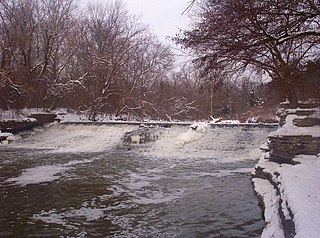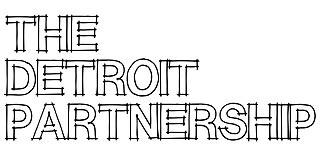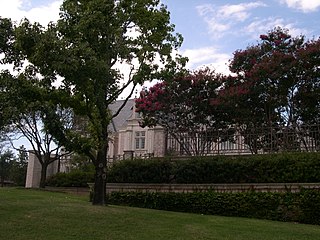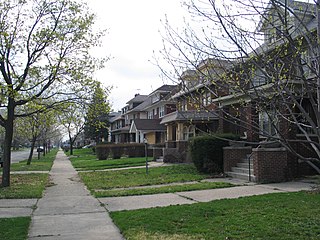
Indian Village is a neighborhood located in Detroit, Michigan, bounded to the north and south by Mack Avenue and East Jefferson Avenue, respectively, along the streets of Burns, Iroquois, and Seminole. The district was listed on the National Register of Historic Places in 1972.

The River Rouge is a 127-mile river in the Metro Detroit area of southeastern Michigan. It flows into the Detroit River at Zug Island, which is the boundary between the cities of River Rouge and Detroit.
Warrendale is a neighborhood located in Detroit, Michigan, bordered by Greenfield Road, Joy Road, and the Detroit city limits. Warrendale neighbors Dearborn on two sides and Dearborn Heights on another side.

The Detroit Partnership (DP), known as The Detroit Project until 2008, is a student-run organization at the University of Michigan with the mission of connecting the Ann Arbor and Detroit communities through active service-learning. Each year, the group holds weekly programs with over 200 students volunteering as tutors and mentors in schools, churches, and non-profits in the Brightmoor, East Side, and Southwest neighborhoods of Detroit. In addition to weekly service-learning programs, the organization also holds two large events. In the fall, The Detroit Partnership partners with community members to bring a large food and clothing drive titled One-Stop Shop to the citizens of Brightmoor and surrounding areas. Also, every March or April, the group routinely brings approximately 1300 student volunteers from the University of Michigan to sites in and around the city of Detroit for a one-day service-learning event known as DP Day.

Preston Hollow is a neighborhood in north Dallas, Texas, United States. It is bordered on the south by the city of University Park.

Midtown Detroit is a commercial and residential district located along the east and west side of Woodward Avenue, north of Downtown Detroit, and south of the New Center area. The area includes several historic districts. In addition, it contains a residential area of some 14,550 people and covers 2.09 sq mi. The community area of neighborhoods is bounded by the Chrysler Freeway (I-75) on the east, the Lodge Freeway (M-10) on the west, the Edsel Ford Freeway (I-94) on the north, and the Fisher Freeway (I-75) on the south.
Conant Gardens is a historically Black neighborhood in northeast Detroit, Michigan. The neighborhood was once the most exclusive Black neighborhood in that city, and residents of Conant Gardens comprised the most highly educated Black enclave in Detroit.

The Virginia Park Historic District is located on the north side of New Center, an area in Detroit, Michigan, along both sides of Virginia Park Street from Woodward Avenue to the John C. Lodge Freeway access road. The district was listed on the National Register of Historic Places in 1982.

Atkinson Avenue is an east–west street located in the geographic heart of the city of Detroit, Michigan. The historic district had 225 houses in 2010.

The Palmer Park Apartment Building Historic District is a neighborhood located in Detroit, Michigan, bounded by Pontchartrain Boulevard on the west, McNichols Road on the south, and Covington Drive on the northeast. A boundary increase pushed the eastern boundary to Woodward Avenue. The district showcases some of the most ornate and most varied examples of apartment building design in Michigan, and was listed on the National Register of Historic Places in 1983.

Rosedale Park is a historic district located in Detroit, Michigan. It is roughly bounded by Lyndon, Outer Drive, Grand River Avenue, Southfield Freeway, Glastonbury Avenue, Lyndon Street and Westwood Drive. It was listed on the National Register of Historic Places in 2006. The Rosedale Park district has the largest number of individual properties of any district nominated to the National Register of Historic Places in Michigan, with 1533.
Sherwood Forest is a neighborhood in Detroit, Michigan. The neighborhood is bounded by Seven Mile Road, Livernois, Pembroke, and Parkside. The community, with about 435 houses, consists of two subdivisions: Sherwood Forest and Sherwood Forest Manor.
Redford High School was a secondary school in Detroit, Michigan. A part of Detroit Public Schools, the school opened in September 1921 and ceased operations in June 2007. Staffed and operated by the Detroit Public Schools; Redford High School served the sub-communities of Old Redford, Grandmont, Rosedale Park and Brightmoor.
City Mission Academy is a private, non-denominational Christian, charitable organization and K-5 school operating in the community of Brightmoor, Detroit, since 1998.

MorningSide is a neighborhood on the east side of Detroit, Michigan. The area is bounded by Harper Avenue and Interstate 94 on the north, Mack Avenue to the south, East Outer Drive and Whittier on the east and Alter Road and East Outer Drive to the west. The local association that shares the name MorningSide with the community is a collaboration of residents working together to take care of this area.

Boynton and Oakwood Heights are the two southernmost neighborhoods of the city of Detroit in the U.S. state of Michigan. The two neighborhoods occupy the only portions of Detroit located south of the River Rouge.
Eliza Howell Park is a public park in Brightmoor, Detroit, Michigan. Howell Park, east of Telegraph Road between Fenkell Avenue and Schoolcraft Avenue, has 250 acres (100 ha) of land, making it the fourth largest park in Detroit; this is about one fourth of the area of Belle Isle or .25 square miles (0.65 km2). A greenway links Howell with Stoepel Park. Howell has a 1.5-mile (2.4 km) nature trail that, in 2009, was recently constructed.
Osborn is a community in northeast Detroit, Michigan. The Skillman Foundation selected Osborn to be one of the neighborhoods covered by the Good Neighborhoods Initiative.
Krainz Woods is a neighborhood in Detroit, Michigan.















